

Rainbow Herbicides. The Rainbow Herbicides are a group of chemicals used by the United States military in Southeast Asia during the Vietnam War.

Success with Project AGILE field tests with herbicides in South Vietnam in 1961 and inspiration by the British use of herbicides and defoliants during the Malayan Emergency in the 1950s led to the formal herbicidal program Trail Dust (1961–71). Herbicidal warfare is the use of substances primarily designed to destroy the plant-based ecosystem of an agricultural food production and/or destroying foliage which provides the enemy cover. The Agents used in southeast Asia, their active ingredients and years used were as follow:[1] In Vietnam, the early large-scale defoliation missions (1962-1964) used 8,208 gallons of Agent Green, 122,792 gallons of Pink, and 145,000 of Purple. These were dwarfed by the 11,712,860 gallons of Orange (both versions) used from 1965 to 1970. See also[edit] References[edit] Further reading[edit] Alvin L. Colt revolving rifle.
Useful_knots. While attending US Army Ranger School back in 1972 and again in 1979.

(Yep that's right, I didn't make it through the first time.) We had to learn how to make and use over a dozen different types of knots during the "mountain phase" of Ranger School, which was up at Camp Merril located in Dahlonega, Georgia. We not only had to master all these different types of knots but how to repel, belay, put in anchor points, rope management and learn the fundamentals of climbing and rappelling up & down mountains and cliffs. How to Tie Knots Like a Navy SEAL. For the next few weeks, we’ll depart from our usual “Knot of the Week” to bring you a series on the knots taught to Navy SEAL candidates at BUD/s (Basic Underwater Demolition/SEAL Training).
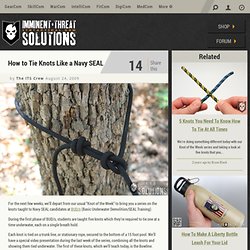
Navy Sets World Record With Incredible, Sci-Fi Weapon. U.S.
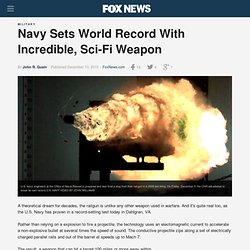
Navy engineers at the Office of Naval Research prepared and test-fired a slug from their rail gun in a 2008 test firing. On Friday, December 9, the ONR will attempt to break its own record.U.S. Navy video by John Williams A theoretical dream for decades, the railgun is unlike any other weapon used in warfare. Enfilade and defilade. Enfilade and defilade are concepts in military tactics used to describe a military formation's exposure to enemy fire.
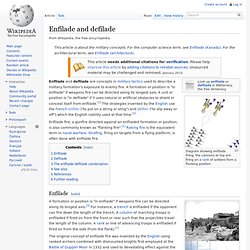
A formation or position is "in enfilade" if weapons fire can be directed along its longest axis. A unit or position is "in defilade" if it uses natural or artificial obstacles to shield or conceal itself from enfilade.[1] The strategies invented by the English use the French enfiler ("to put on a string or sling") and défiler ("to slip away or off") which the English nobility used at that time.[2] Enfilade fire, a gunfire directed against an enfiladed formation or position, is also commonly known as "flanking fire".[1] Raking fire is the equivalent term in naval warfare. Strafing, firing on targets from a flying platform, is often done with enfilade fire.
Enfilade[edit] Top to bottom: a German bunker on Juno Beach with wounded Canadian soldiers, 6 June 1944. Defilade[edit] Father of All Bombs. Aviation Thermobaric Bomb of Increased Power (ATBIP) (Russian: Авиационная вакуумная бомба повышенной мощности (АВБПМ)), nicknamed "Father of All Bombs" (FOAB) (Отец всех бомб), is a Russian-made air-delivered/land-activated thermobaric weapon.
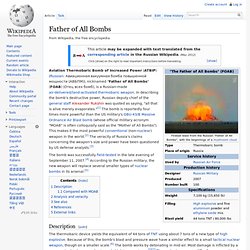
In describing the bomb's destructive power, Russian deputy chief of the general staff Alexander Rukshin was quoted as saying, "all that is alive merely evaporates. 9mm vs .45ACP: Really? Again? Yes, again.

Amongst avid handgun fans the debate between big and slow versus small and fast stretches back over a hundred years now I'd guess. Next year marks the 100 year anniversary of the Government Model 1911 .45ACP having been adopted by the U.S. Police car. Police BMW X5, with active visual warnings showing, escorts riders on the Tour of Britain The first police car was a wagon run by electricity fielded on the streets of Akron, Ohio, in 1899.
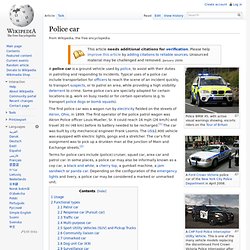
The first operator of the police patrol wagon was Akron Police officer Louis Mueller, Sr. It could reach 16 mph (26 km/h) and travel 30 mi (48 km) before its battery needed to be recharged.[1] The car was built by city mechanical engineer Frank Loomis. The US$2,400 vehicle was equipped with electric lights, gongs and a stretcher. The car's first assignment was to pick up a drunken man at the junction of Main and Exchange streets.[2] Usage[edit] In some areas of the world, the police car has become more widely used than police officers "walking the beat". Advocates[attribution needed] of community policing often cite this shift into vehicles, and away from face to face contact, as a reason for breakdowns in relations with the community. Functional types[edit] There are several types of police car. Dogs in warfare. Dogs in warfare have a long history starting in ancient times.
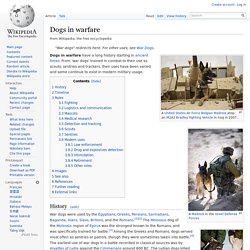
From 'war dogs' trained in combat to their use as scouts, sentries and trackers, their uses have been varied and some continue to exist in modern military usage. History[edit] During the Late Antiquity, Attila the Hun used giant Molosser dogs in his campaigns.[1] Gifts of war dog breeding stock between European royalty were seen as suitable tokens for exchange throughout the Middle Ages.
Other civilizations used armored dogs to defend caravans or attack enemies. The Spanish conquistadors used armored dogs that had been trained to kill natives.[6]